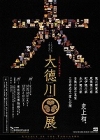Japanese Archaeology and Special Exhibition (Heiseikan) Special Exhibition Galleries
October 10, 2007 (Wed) - December 2, 2007 (Sun)
Features the treasures of the Tokugawa Shogun family and its three branch families. The exhibition attempts to introduce the essence of the culture of Edo warriors through portraits and the military attire of the Edo Shoguns and works related to tea, together with gorgeous outfits and belongings of the high-class women.

